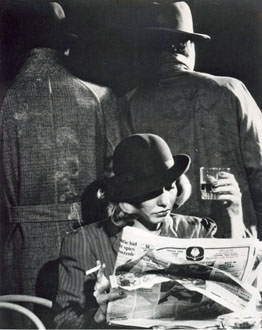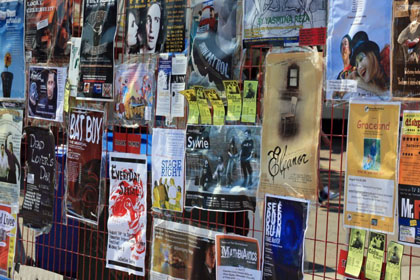Browse "Arts & Culture"
-
Article
Arts Commons
Arts Commons (formerly the EPCOR Centre for the Performing Arts and the Calgary Centre for Performing Arts) is the largest performing arts facility in Western Canada and one of the three largest in the country.
"https://d2ttikhf7xbzbs.cloudfront.net/media/media/49f11ae6-e2be-4d83-8489-c998ea88c98a.jpg" // resources/views/front/categories/view.blade.php
https://d2ttikhf7xbzbs.cloudfront.net/media/media/49f11ae6-e2be-4d83-8489-c998ea88c98a.jpg
-
Article
EPCOR Centre for the Performing Arts
Cohen's committee eventually raised $15 million from the private sector. Work began in 1981 and the centre opened in 1985, built at a cost of $79.9 million. Municipal and provincial governments contributed to a fixed annual operating grant of $2.4 million.
"https://d2ttikhf7xbzbs.cloudfront.net/media/media/1497ddbb-36aa-4d6e-8439-40d1ac3f3e7e.jpg" // resources/views/front/categories/view.blade.php
https://d2ttikhf7xbzbs.cloudfront.net/media/media/1497ddbb-36aa-4d6e-8439-40d1ac3f3e7e.jpg
-
Article
Espace GO
Espace GO. One of Montréal's main theatrical institutions, Espace GO, which has existed under this name since the early 1990s, stems from the Théâtre Expérimental des Femmes (TEF), whose heritage it preserves, in part.
"https://development.thecanadianencyclopedia.ca/images/tce_placeholder.jpg?v=e9dca980c9bdb3aa11e832e7ea94f5d9" // resources/views/front/categories/view.blade.php
https://development.thecanadianencyclopedia.ca/images/tce_placeholder.jpg?v=e9dca980c9bdb3aa11e832e7ea94f5d9
-
Article
Espace Libre
Espace Libre. A space for creation and dissemination dedicated to experimental theatre and research, Espace Libre marked the 30th anniversary of its founding in 2009.
"https://development.thecanadianencyclopedia.ca/images/tce_placeholder.jpg?v=e9dca980c9bdb3aa11e832e7ea94f5d9" // resources/views/front/categories/view.blade.php
https://development.thecanadianencyclopedia.ca/images/tce_placeholder.jpg?v=e9dca980c9bdb3aa11e832e7ea94f5d9
-
Article
Factory Theatre
Gass, along with co-founder Frank Trotz, borrowed $3000 to launch the company, whose first home was in a greasy former candle factory above an auto-body shop at 374 Dupont Street.
"https://d2ttikhf7xbzbs.cloudfront.net/media/media/314afe7b-e739-4d34-b72e-0f60a9af41fc.jpg" // resources/views/front/categories/view.blade.php
https://d2ttikhf7xbzbs.cloudfront.net/media/media/314afe7b-e739-4d34-b72e-0f60a9af41fc.jpg
-
Article
Festival Theatre
The term "festival theatre" emerged in England in the nineteenth century to refer to special theatrical performances mounted to celebrate exceptional authors or dates. The festival held in 1864 at Stratford-Upon-Avon, England, to mark the tercentenary of Shakespeare's birth is an early example.
"https://d2ttikhf7xbzbs.cloudfront.net/media/media/5c9b172d-1120-47c2-9133-24b41f9f1973.jpg" // resources/views/front/categories/view.blade.php
https://d2ttikhf7xbzbs.cloudfront.net/media/media/5c9b172d-1120-47c2-9133-24b41f9f1973.jpg
-
Article
Festival TransAmériques (former Festival de Théâtre des Amériques) (FTA)
Festival TransAmériques (formerly the Festival de Théâtre des Amériques) (FTA).
"https://development.thecanadianencyclopedia.ca/images/tce_placeholder.jpg?v=e9dca980c9bdb3aa11e832e7ea94f5d9" // resources/views/front/categories/view.blade.php
https://development.thecanadianencyclopedia.ca/images/tce_placeholder.jpg?v=e9dca980c9bdb3aa11e832e7ea94f5d9
-
Article
Music in Fredericton
Fredericton, NB. New Brunswick's capital city, located on the Saint John River on the site of a 1732 Acadian, and later Loyalist English, settlement at St Anne's Point. The name Fredericton was adopted in 1785. Incorporation as a city was accomplished in 1848.
"https://development.thecanadianencyclopedia.ca/images/tce_placeholder.jpg?v=e9dca980c9bdb3aa11e832e7ea94f5d9" // resources/views/front/categories/view.blade.php
https://development.thecanadianencyclopedia.ca/images/tce_placeholder.jpg?v=e9dca980c9bdb3aa11e832e7ea94f5d9
-
Macleans
Gehry's Bilbao Museum Sensation (Nov97 Updates)
In architectural circles, they are calling it a masterpiece, the crowning achievement of Canadian-born, California-based Gehry's long career.This article was originally published in Maclean's Magazine on November 3, 1997
"https://d2ttikhf7xbzbs.cloudfront.net/media/media/ce03a686-a5ff-4235-ac06-c33d8f41618d.jpg" // resources/views/front/categories/view.blade.php
https://d2ttikhf7xbzbs.cloudfront.net/media/media/ce03a686-a5ff-4235-ac06-c33d8f41618d.jpg
-
Article
George's Jazz Room
George's Jazz Room (George's Spaghetti House, 1956-84). Restaurant, the longest-running jazz club in Canada.
"https://development.thecanadianencyclopedia.ca/images/tce_placeholder.jpg?v=e9dca980c9bdb3aa11e832e7ea94f5d9" // resources/views/front/categories/view.blade.php
https://development.thecanadianencyclopedia.ca/images/tce_placeholder.jpg?v=e9dca980c9bdb3aa11e832e7ea94f5d9
-
Article
Music in Guelph
Guelph, Ont. Founded 1827 by John Galt in the heart of agricultural Ontario and incorporated in 1879. In 1846 there were 1240 people living in Guelph. By 1988 the population had reached 80,786 including a large Italian.community.
"https://development.thecanadianencyclopedia.ca/images/tce_placeholder.jpg?v=e9dca980c9bdb3aa11e832e7ea94f5d9" // resources/views/front/categories/view.blade.php
https://development.thecanadianencyclopedia.ca/images/tce_placeholder.jpg?v=e9dca980c9bdb3aa11e832e7ea94f5d9
-
Article
Habitat 67
Habitat 67 is an experimental urban residential complex designed by Israeli-born architect Moshe Safdie and located in the Cité du Havre neighbourhood south of Montréal’s Old Port sector. Commissioned by the Canadian Corporation for Expo 67, the project derives its name from the theme of the fair, “Man and His World,” and became one of the major pavilions of the exhibition. It is the only remaining structure from Expo 67 to retain its original function. In 2015, the Guardian called Habitat “a functioning icon of 1960s utopianism, and one of that period’s most important buildings.”
"https://d2ttikhf7xbzbs.cloudfront.net/media/new_article_images/Habitat67/d378c1fa-9a6d-400c-aa2b-eb5b8351d306.jpg" // resources/views/front/categories/view.blade.php
https://d2ttikhf7xbzbs.cloudfront.net/media/new_article_images/Habitat67/d378c1fa-9a6d-400c-aa2b-eb5b8351d306.jpg
-
Article
Music in Halifax
Capital of Nova Scotia and major seaport established in 1749 as a British settlement (population 2500) and military base. The influx of Loyalists resulting from the American Revolution caused the population to rise to about 9000 by 1800.
"https://development.thecanadianencyclopedia.ca/images/tce_placeholder.jpg?v=e9dca980c9bdb3aa11e832e7ea94f5d9" // resources/views/front/categories/view.blade.php
https://development.thecanadianencyclopedia.ca/images/tce_placeholder.jpg?v=e9dca980c9bdb3aa11e832e7ea94f5d9
-
Article
Music in Hamilton
City on Lake Ontario with a natural bay as harbour. Taking its name from George H. Hamilton (1787-1835), who laid it out in 1813, the town was incorporated as a city in 1846 when, with a population of 10,000, it was the second-largest city in Upper Canada.
"https://development.thecanadianencyclopedia.ca/images/tce_placeholder.jpg?v=e9dca980c9bdb3aa11e832e7ea94f5d9" // resources/views/front/categories/view.blade.php
https://development.thecanadianencyclopedia.ca/images/tce_placeholder.jpg?v=e9dca980c9bdb3aa11e832e7ea94f5d9
-
Article
Hamilton Place
Hamilton Place (formally Ronald V. Joyce Centre for the Performing Arts at Hamilton Place). Multi-purpose arts centre, situated on Main St in downtown Hamilton, Ont.
"https://development.thecanadianencyclopedia.ca/images/tce_placeholder.jpg?v=e9dca980c9bdb3aa11e832e7ea94f5d9" // resources/views/front/categories/view.blade.php
https://development.thecanadianencyclopedia.ca/images/tce_placeholder.jpg?v=e9dca980c9bdb3aa11e832e7ea94f5d9
